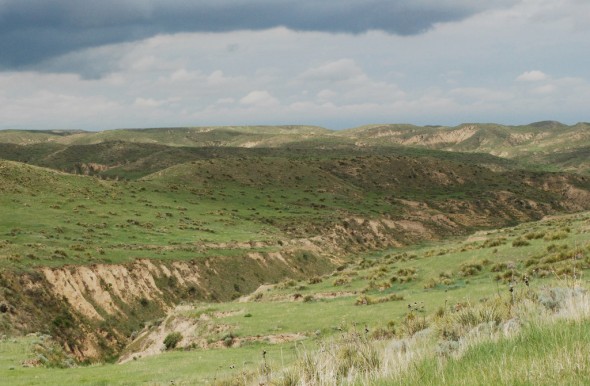TakePart | May 31, 2014

The Arikaree Breaks in northwestern Kansas is home to ancient soils that were covered in loess deposits over thousands of years. Photo by Joe courtesy Creative Commons.
Although most of the attention given to greenhouse gas has focused on the air around and above us, another significant source of carbon could contribute to climate change and has been unaccounted for: soot and fossils buried in soil that formed up to 15,000 years ago.
That’s the conclusion of a new study by researchers at the University of Wisconsin–Madison, who dug as much as six and a half meters below the surface in Kansas, Nebraska, and other parts of the Great Plains to reach ancient soils filled with black carbon and plants that have not yet fully decomposed. These carbon stores could be released into the environment via erosion, road construction, mining, or deforestation.
“It was assumed that there was little carbon in deeper soil,” said Erika Marín-Spiotta, a professor at UW-Madison and a coauthor of the study, published earlier this week in the journal Nature Geoscience. Most soil studies don’t penetrate deeper than 30 centimeters, she said, leading scientists to dramatically underestimate underground carbon reserves.
Only recently have scientists become more concerned about deep soil carbon, Marín-Spiotta said. Her research team believes a situation similar to that which it has documented in the American Midwest may exist elsewhere, such as in China and France. Because such carbon reservoirs in buried soils can lurk in a range of environments—under dust accumulation, in floodplains, in valleys, at the foot of slopes of hills and mountains and under lava flows—they are likely to occur in many other parts of the world.
Just how much carbon are we talking about? While it’s hard to get a global estimate, Marín-Spiotta said as much as 5.95 trillion pounds of carbon could be lurking in the depths of the Great Plains area her team looked at. That’s assuming the ancient soil forms a continuous layer across the region; the researchers were only able to collect measurements from specific points and don’t really know what portion of the region contains the carbon-rich soil, so Marín-Spiotta acknowledges that’s a high estimate.
“The large source of uncertainty is where these buried soils are located, at what depth do they occur, and over what spatial extent,” she said.
How could this giant carbon bomb be released? In some areas, it has already been exposed to the atmosphere. But for the subterranean reserves, Marín-Spiotta believes a number of factors are at work, including how much carbon there really is, how much has persisted since it was buried, and what kind of carbon is down there.
Though Marín-Spiotta says the buried reserves carbon don’t pose an immediate risk to rising CO2 levels in the atmosphere, she notes that land managers need to take precautions, as the researchers found the ancient soils are more reactive than was previously understood. Key among these, she said, would be to “estimate whether there are any [high-carbon] soils at a particular location [and if so] prevent erosion and exposure that would accelerate…release of CO2 to the atmosphere.”
Photo of the Arikaree Breaks in Kansas by Joe courtesy of Creative Commons
View the original story here.